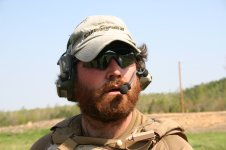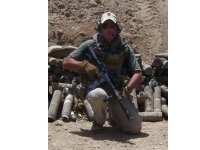Oldgateboatdriver
Army.ca Veteran
- Reaction score
- 1,583
- Points
- 1,010
I see the LRDG / SAS .... I mean the Rat Patrol, has entered the chat.
Well played, Rudburg.
Well played, Rudburg.

Yeah and I can tell they never drove in Afghanistan. I played Rat Patrol for a bit - as soon as you hit one of the shit and piss filled run offs in a street, it splashes on your face. When combined with the fuel run off you’re never getting that out of a beard.


Yeah and I can tell they never drove in Afghanistan. I played Rat Patrol for a bit - as soon as you hit one of the shit and piss filled run offs in a street, it splashes on your face. When combined with the fuel run off you’re never getting that out of a beard.
I have seen women struggle with maintaining longer hair in the field, have a tougher time fitting equipment, and all because of a vanity, not a necessity.The policy allows commanders to restrict grooming standards for operational reasons.
Did women with long hair perform at lower standards than those other women with short hair in Afghanistan?
Yes, we need a single standard for all. That standard is not short hair for everyone. The environment between WW1 and now are very different and the reason short hair was mandated then may not apply today.
You can find examples of exemptions to anything. Special forces aren’t going to be following general policy in equipment, attire, and tactics, they tend to adapt to whatever the specific mission is. Trying to base general policy on them isn’t necessarily the best course of action.Fair point. I recognize that the desert version of the SAS isn't a perfect example of what operational soldiers should look like at all times. But they are operational soldiers, and pretty good ones at that. In another picture taken at the same time, their CO is standing right next to them, so clearly he didn't care what they looked like.
I was making a quick rebuttal to a point that Eaglelord had made and then doubled down on - that literally everyone should shave their entire head and face at all times, "because lessons learned in war." I've read plenty of WW1 and WW2 AARs and I've never seen haircuts being mentioned.
I feel like telling women that they had to shave their head would lead to a lot of VR's and an even bigger shortage of women looking to join the forces.The policy allows commanders to restrict grooming standards for operational reasons.
Did women with long hair perform at lower standards than those other women with short hair in Afghanistan?
Yes, we need a single standard for all. That standard is not short hair for everyone. The environment between WW1 and now are very different and the reason short hair was mandated then may not apply today.
You can find examples of exemptions to anything. Special forces aren’t going to be following general policy in equipment, attire, and tactics, they tend to adapt to whatever the specific mission is. Trying to base general policy on them isn’t necessarily the best course of action.
Why would you find examples of haircuts being mentioned in AARs? It was the standard, anything other than that was the deviation.
Clean shaven is directly related to the gas attacks of WWI. Everyone went into that war with long hair and beards. Everyone came out with short hair and clean shaven.
I was making a quick rebuttal to a point that Eaglelord had made and then doubled down on - that literally everyone should shave their entire head and face at all times, "because lessons learned in war." I've read plenty of WW1 and WW2 AARs and I've never seen haircuts being mentioned.
I was also wondering what those "lessons learned" were. Was the learning restricted solely to the Canadian Army or would due consideration be given to the experience of other major participants, like the (British) Indian Army?
I was just being a smart ass - and relating one personal experience.Fair point. I recognize that the desert version of the SAS isn't a perfect example of what operational soldiers should look like at all times. But they are operational soldiers, and pretty good ones at that. In another picture taken at the same time, their CO is standing right next to them, so clearly he didn't care what they looked like.
I was making a quick rebuttal to a point that Eaglelord had made and then doubled down on - that literally everyone should shave their entire head and face at all times, "because lessons learned in war." I've read plenty of WW1 and WW2 AARs and I've never seen haircuts being mentioned.
On the topic of lice - this was a nuisance for soldiers . . .
Here is the regulationsok admitting up front - I am being lazy here.
Can someone advise on the current dress regs in regards to males wearing earrings? I am wondering as I recently saw a couple members wearing what I know was not at standard before and do not recall an amendment sent around to change it. One had black ear expanders, the other had large coloured stones. last I saw we were now allowed to wear to the old standard of small diamond or gold balls centred in the lobe that female members have worn for years. Also wondering if we are still restricted to one earring in each ear.
Personally I find the NBCW argument for masks to be a red herring, as to have any actual chance you need a sealed non permeable suit that has its own air. Obviously those are expensive, and so the respirator is there to lull folks into a sense of security that doesn't exist, kind of like the bayonet to get young troops willing to rush forward into danger --> Rangers Lead the Way - I'm going to sit here and see what happens
The question I raised in my post was rhetorical with a tinge of sarcasm, but thanks for responding. Lice. How can I count the ways it's a nuisance? Actually, I did count them once, back in the 1970s, in Wainwright, when I assisted in checking a company for lice (pubic lice) when severalmembersof its soldiers reported on sick parade at the same time with the same crotch critter complaint. A few of them had been entertained by the same "lady" prior to deploying on ex. Whether it was warranted to check everyone for migratory pests (despite the claim of a couple of the guys that they had nothing do with the girl, you can't get crabs off a toilet seat), when you spend a couple of hours examining other men's nether regions, nuisance is an understatement.

I'm sorry Kevin, but that is absolutely untrue.Personally I find the NBCW argument for masks to be a red herring, as to have any actual chance you need a sealed non permeable suit that has its own air.
Well ever wonder why SOF (inc CANSOF) don’t go poking around nasty places in standard gear?I'm sorry Kevin, but that is absolutely untrue.
I know you worked at DRES and have live agent experience— but just like USAMRID, ever wonder why the folks in the lab have different stuff?
Or why when doing LA stuff there was folks in the full meal deal?
I have seen women struggle with maintaining longer hair in the field, have a tougher time fitting equipment, and all because of a vanity, not a necessity.
Can people do the job with longer hair? Yeah most the time it would be fine. Can people do the job in civvies? Yeah most the time. Is it best practice? No for both.